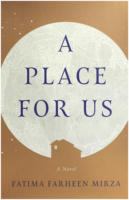Last Updated on September 23, 2022 by themigrationnews

SJP for Hogarth, New York
385 Pages, ISBN 978152463558, Ebook ISBN 9780525575825
A Place for Us by Fatima Farheen Mirza is a story of an American family about faith, honour, and betrayal. It is the coming-of-age story of Amar, a young Indian American Muslim in post-9/11 America. The novel revolves around Amar’s place within his family and the Indian Muslim community’s place in the United States. Amar questions the faith and culture of his parents, who have migrated with them to the US.
His parents, Rafiq and Layla, have migrated from India to California. They try to raise their three children, Hadia, Huda, and Amar, with their culture and tradition. The culture and traditions of the family both push them together and pull them apart. The parents, who are first-generation immigrants, feel a loss of tradition because they see their children drifting away from their culture. While their children, who are second-generation immigrants, try to integrate both their worlds together. This integration which is both a gain and a loss leads to a generational shift. Rather than choosing sides, Mirza negotiates between the guilt and the excitement experienced by second-generation immigrants.
The novel opens with the wedding scene of Hadia, the eldest sister. Hadia has chosen a love match instead of the traditional arranged marriage. Although she has drifted from the traditional setup, she keeps her relationship with Tariq halal (religiously acceptable). Hadia honours where she is from but also chooses the man she wants. Amar, who has been estranged from his family for three years, has come home to attend his sister’s wedding. There is a pronounced disconnect between him and his family. This novel explores why he left and what role did the family members play in his decision to run away.
The novel is narrated from multiple perspectives of all the characters by an omniscient narrator who lets the readers decide their take on the characters and their decisions. The book interweaves the past with the present, migrating back and forth through several decades. It dives into the memories and decisions made by each character that resulted in their family falling apart. The novel discusses the conflict in value systems between the generations. While Amar’s decisions are good from his own perspective, it is covered with a selfish tint when viewed from his mother’s perspective.
The novel takes an exploratory approach, where both the narrator and readers answer the questions together. It questions if Amar is different because he struggles to believe in the faith that his family does. Amar keeps trying to go back and understand the religious stories his mother told him during his childhood. Hadia, on the other hand, comes across as a practicing Muslim, but in her mind, she does not think of her life in terms of faith.
The title of the book, as stated by the author, “is an acknowledgement” (Mirza). The novel is hopeful that there is a place where the characters can exist without conflict. The novel explores the concept of a homeland and how the space for a home is created. The meaning of home for each character is different. While Rafiq and Layla consider India as their home, Hadia and Huda regard America as their home. Amar, on the other hand, is not spatially bound and thinks “home is home when Hadia is in it” (Mirza). The book discusses the construction of three spaces- the place of each character within the family, the family’s place within their community, and the place of the Indian Muslim diaspora community in America. Their place in these spaces leads to the formation of their identity.
The book contrasts the identity of the characters as an individual, as a part of their family, and their identity in their community. Identity can be categorised into personal identity and social identity. According to the self-categorization theory, personal identity refers to “the individual as a unique person in terms of their individual differences from other (ingroup) persons” (Turner). Whereas social identity refers to “social categorizations of self and others, self-categories which define the individual in terms of his or her shared similarities with members of certain social categories in contrast to other social categories”. Thus, social identity constructs a contrast of “us” versus “them” (Turner). This social construct is thrust not only between immigrants and the host country but also within the members of the immigrant community, of which a family is a basic unit. The novel is structured around Amar and his struggle in the formation of his identity.
A Place for Us is the first book to be published by Sarah Jessica Parker’s new imprint for Hogarths. It is a project between a first-time author and a publisher. Fatima Farheen Mirza invested eight years in writing this enthralling story that resonates with readers beyond the diasporic community. You need not be an immigrant to relate to the shift in family tensions and generational clashes the book discusses.
Works Cited
“Fatima Farheen Mirza on the title A Place for Us.” Youtube, uploaded by Crown Publishing Group, 31 May 2018, https://www.youtube.com/watch?v=A85HUc5tUYQ
Mirza, Fatima Farheen. A Place for Us: A Novel. Reprint, SJP for Hogarth, 2019.
Turner, John C., Personal and Social Identity: Self and Social Context, Personality and the Social Psychology Bulletin Special Issue on the Self and the Collective, 30 April 1992.

Irram Irfan is a PhD research scholar at English and Foreign Languages University at Hyderabad, India. Her research interests include Migration Studies, Postcolonial Literature and Transnational Studies.
